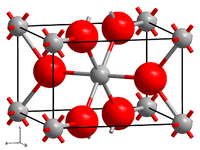Magnesium fluoride
| Crystal structure | |||||||||||||||||||
|---|---|---|---|---|---|---|---|---|---|---|---|---|---|---|---|---|---|---|---|

|
|||||||||||||||||||
| __ Mg 2+ __ F - | |||||||||||||||||||
| General | |||||||||||||||||||
| Surname | Magnesium fluoride | ||||||||||||||||||
| other names |
|
||||||||||||||||||
| Ratio formula | MgF 2 | ||||||||||||||||||
| Brief description |
colorless odorless tetragonal crystals |
||||||||||||||||||
| External identifiers / databases | |||||||||||||||||||
|
|||||||||||||||||||
| properties | |||||||||||||||||||
| Molar mass | 62.31 g mol −1 | ||||||||||||||||||
| Physical state |
firmly |
||||||||||||||||||
| density |
3.13 g cm −3 |
||||||||||||||||||
| Melting point |
1256 ° C |
||||||||||||||||||
| boiling point |
2260 ° C |
||||||||||||||||||
| solubility |
bad (0.13 g l −1 ) in water |
||||||||||||||||||
| safety instructions | |||||||||||||||||||
|
|||||||||||||||||||
| MAK |
1 mg m −3 |
||||||||||||||||||
| As far as possible and customary, SI units are used. Unless otherwise noted, the data given apply to standard conditions . | |||||||||||||||||||
Magnesium fluoride is a chemical compound made from magnesium and fluorine . It belongs to the group of salts and occurs as a white powder or as colorless crystals.
Occurrence
Magnesium fluoride was first described as a mineral in 1868 by the Italian mining engineer Quintino Sella (1827-1884). It is named Sellait after him . The natural occurrences have no economic significance.
Extraction and presentation
In contrast to magnesium chloride , magnesium fluoride is poorly soluble in water. The simplest and most economical way of producing fluoride is therefore to precipitate it from a solution of magnesium chloride with hydrofluoric acid .
In addition, magnesium fluoride can also be obtained by dissolving metallic magnesium or magnesium carbonate in hydrofluoric acid or directly from the elements magnesium and fluorine, the latter reaction being strongly exothermic.
properties
Magnesium fluoride forms colorless and odorless incombustible crystals that crystallize tetragonally in the rutile structure . The Mohs hardness is 6. The standard enthalpy of formation is −1124 kJ / mol. MgF 2 is chemically very stable and is only attacked by hot sulfuric acid .
Magnesium fluoride has some optical properties that make it interesting for technical applications. It is transparent in an exceptionally wide range of wavelengths . This range extends from around 120 nm ( VUV radiation ) to around 8 µm ( infrared ). In addition, it has relatively low indices of refraction of around 1.38 in the visible region of the spectrum . Furthermore, MgF 2 shows positive birefringence .
use
The optical properties of magnesium fluoride, together with its chemical stability, make it an important material for optical applications. Its low refractive index makes it well suited for the production of anti-reflective coatings . B. to anti-reflective glasses or photo optics. Because of the transmission reaching far into the UV range , MgF 2 is also used to seal aluminum- coated mirrors that work in this range. As a single crystal , magnesium fluoride is used for optical windows that require a wide range of transparency.
There are also a number of applications outside of the optical industry, including as an additive for ceramics and as a catalyst in the chemical industry, in metallurgy as a welding agent for light metals, as a carrier for catalysts and to increase the resistance and gas tightness of moldings made of aluminum oxide .
Individual evidence
- ↑ Entry on MAGNESIUM FLUORIDE in the CosIng database of the EU Commission, accessed on March 7, 2020.
- ↑ Entry on magnesium fluoride. In: Römpp Online . Georg Thieme Verlag, accessed on July 14, 2014.
- ↑ a b c data sheet magnesium fluoride (PDF) from Merck , accessed on January 19, 2011.
- ^ H. Kojima, SG Whiteway, CR Masson: Melting points of inorganic fluorides . In: Canadian Journal of Chemistry . 46 (18), 1968, pp. 2968-2971, doi : 10.1139 / v68-494 .
- ↑ a b c d Entry for CAS no. 7783-40-6 in the GESTIS substance database of the IFA , accessed on October 17, 2012(JavaScript required) .
- ↑ G. Brauer (Ed.): Handbook of Preparative Inorganic Chemistry 2nd ed., Vol. 1, Academic Press 1963, pp. 232-233.
